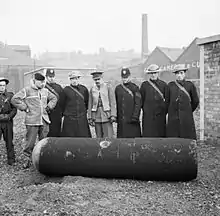Parachute mine
A parachute mine is a naval mine dropped from an aircraft by parachute. They were mostly used in the Second World War by the Luftwaffe and initially by the Royal Air Force (RAF) Bomber Command. Frequently, they were dropped on land targets.

History
Luftwaffe
During the Second World War, the Luftwaffe used a number of different kinds of parachute mine. The Luftmine A (LMA) and Luftmine B (LMB) weighed 500 kg (1,100 lb) and 1,000 kg (2,200 lb) respectively. The LMA was 5 ft 8 in (1.73 m) in length and the LMB 8 ft 8 in (2.64 m).
After the parachute opened, the mine would descend at around 40 miles per hour (64 km/h). If it came down on land, a clockwork mechanism would detonate the mine 25 seconds after impact. If the mine landed in water it would sink to the bottom. If the depth was greater than 8 feet (2.4 m), water pressure and the dissolving of a water–soluble plug would deactivate the clockwork time-detonator, and activate an anti-shipping detonator. These were initially magnetic detonators but later, acoustic or magnetic/acoustic detonators could be fitted.[1] The Luftwaffe began dropping mines in British waters in November 1939, using Heinkel He 115 seaplanes and Heinkel He 111 land–based bombers. The new British cruiser, HMS Belfast, was damaged by a parachute mine on 21 November in the Firth of Forth, while the destroyer HMS Gipsy was damaged at Harwich on the same night.[2]
The threat to shipping posed by magnetic detonators was effectively negated after a German parachute mine was captured intact when it landed in mud in the Thames Estuary. Thereafter, a ship's magnetic field could be counteracted by a process called degaussing. This involved either the installation of electric wires around the inside of the hull, or for smaller vessels, by passing an electric cable under the hull, known as "wiping".[3]
Parachute mines were first used against land targets on 16 September 1940 in the early stages of the Blitz.[1] It was rumoured that Hermann Göring had ordered parachute mines to be dropped on London in a fit of temper, but it is more likely that they were originally intended to disrupt shipping in the London Docks. From October 1940, mines were also dropped in raids on other British cities such as Birmingham, Liverpool, Manchester and Coventry.[2] Clearance of these was carried out by the Royal Navy, which quickly dispatched a team to London from HMS Vernon, while Army Bomb disposal staff were warned that it was extremely inadvisable to attempt to render them safe without Naval guidance.[4] The official British designation for these weapons on land was "Parachute Landmines",[2] but civilians just called them "land mines".[5]
The singer Al Bowlly was killed by a parachute mine which exploded outside his flat in Jermyn Street, London during the Blitz on 17 April 1941.[6]
The use of standard parachute mines declined after 1941, but the Luftwaffe later used the 1,000 kg (2,200 lb) Bombenmine (BM 1000, Monika, or G Mine). This was fitted with a tail made from Bakelite which broke up on impact. It had a photoelectric cell beneath a cover which detonated the bomb if exposed to light to counteract the work of bomb disposal units.[2]
RAF
The RAF initially used naval mines, but replaced them with purpose-made blockbuster bombs, which were produced in various sizes up to 22,000 pounds (10,000 kg).
References
- "Non-Contact, Parachute Ground (Land) Mine Type GC". Imperial War Museum. Retrieved October 1, 2012.
- Boyle, Tony. "Death By Parachute - German Aerial Mine Warfare" (PDF). www.bclm.co.uk. Black Country Living Museum. Retrieved 23 September 2019.
- "Deguassing Ships". navymuseum.co.nz. National Museum of the Royal New Zealand Navy. Retrieved 23 September 2019.
- Major Arthur Hogben. Designed to Kill: Bomb disposal from World War 1 to the Falklands. p. 69. ISBN 0850598656.
- Rattigan, Maurice (7 June 2005). "WW2 People's War - Parachute Mines". bbc.co.uk. BBC History. Retrieved 23 September 2019.
- Whitcomb, Ian. "The Coming of the Crooners". Sam Houston University. Archived from the original on 7 June 2010. Retrieved 24 June 2010.
External links
- Archived Version of page with Illustration.